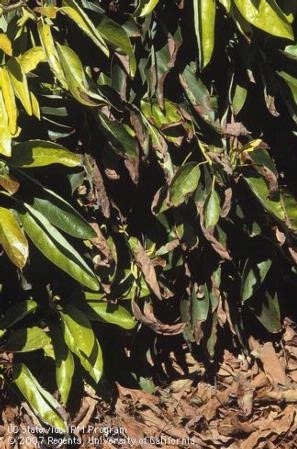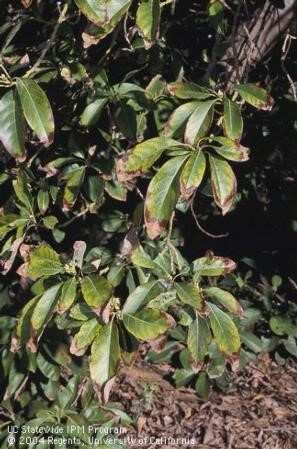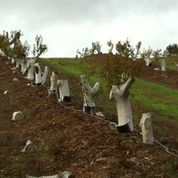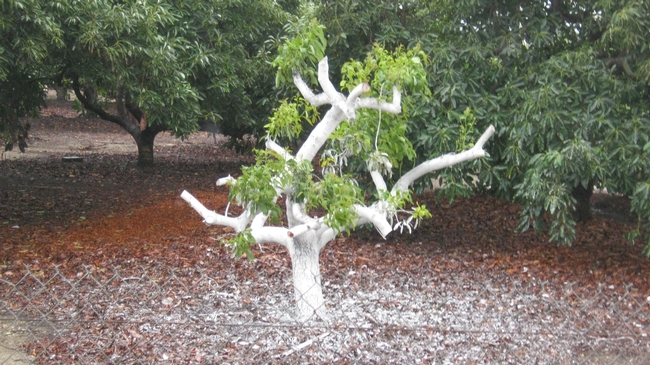Avocados and Water
Avocados are the most salt and drought sensitive of our fruit tree crops. They are shallow rooted and are not able to exploit large volumes of soil and therefore are not capable of fully using stored rainfall. On the other hand, the avocado is highly dependent on rainfall for leaching accumulated salts resulting from irrigation water. In years with low rainfall, even well irrigated orchards will show salt damage. During flowering there can be extensive leaf drop due to the competition between flowers and leaves when there is salt/drought stress. In order to reduce leaf damage and retain leaves, an excess amount of water is required to leach salts out of the roots zone. The more salts in the water and the less rainfall, the greater leaching fraction.
Drought stress often leads to diseases, such as black streak, bacterial canker, and blight (stem, leaf, and fruit). Leaf blight (Figure 1) is often confused with salt or tip burn (Fig. 2), but is actually a fungal disease that forms an irregular dead pattern on leaves and leads to defoliation. Blight is associated with lack of water, while salt burn is due to poor quality water and poor irrigation habits. Leaf blight often shows up after Santa Ana conditions, when growers get behind on their irrigations and the root zone dries out suddenly. There has been a high incidence of this disease the last two years. In both cases, defoliation leads to sunburned trees and fruit which can be severe economic losses. The only way to prevent these conditions is to keep up with your irrigation schedule.
Irrigation Management
To get your water to go further, it is important that the system is tuned in order to get the best distribution uniformity (DU). Many of our systems were installed 40 years ago and old age can lead problems, such as clogging, broken emitters, mixed emitters that put out different amounts and leaks. With poor DU, some trees get too much water and others do not get enough. Even fairly new irrigation systems can have poor DU, especially after a harvest. Poor water pressure on our step slopes is probably our main problem. A DU of 80% means 10% of the emitters are putting out more than the average and 10% are putting out less. The irrigator to compensate for the under irrigated 10% will run the system 10% longer to make sure the under irrigated trees get enough and over irrigating 10% of the trees with 20% more water than they need. A call to the local Resource Conservation District office can get a free DU evaluation and recommendations that are usually pretty reasonable to follow.
Aside from improving DU, it is important to know when and how much water to apply. When to apply can be evaluated by the hand or feel method (https://nutrientmanagement.tamu.edu/content/tools/estimatingsoilmoisture.pdf) which is fast and cheap. Or it can be done by tensiometer, Watermark or some of the more expensive electronic sensors. But these tools only tell you when to irrigate, not how much. This can be done by turning the system on (once you have made sure you have a good DU) and over the period of the irrigation insert a piece of rebar into the soil to determine the depth of infiltration. The rod will go down as far as the soil is moist and stop when it hits dry dirt. When you have about two feet of infiltration you will know how long to run the system to get an appropriate amount of water. A typical loam usually takes about 150 gallons per tree to two feet. Another way to get an approximation of the amount to apply is to use the Irrigation Calculator at http://www.avocadosource.com/tools/IrrigationCalculator.asp.
Managing the Tree Canopy
Significantly pruning trees can reduce the amount of water transpired by the tree. Trees that are about 15 feet in height, can be pruned by half and they will use half the water. Massive 30 foot trees would need to have a major pruning to significantly reduce water use. In extreme drought conditions and for the long term welfare of the grove, large trees should be stumped (Figure 3) or scaffolded (Figure 4) and paint white to prevent sunburn. Scaffolding usually produces fruit much sooner than stumping, because retaining a significant part of the trunk and branches the tree does not exert as much energy to regrow and retains buds that have been under apical dominance for less time. When new shoots appear they should be headed back to force lateral branches which is where the flowers will form.
All the prunings should be chipped and left in the field. This will help conserve water and help control Phytophthora root rot. Root rot or crown rot trees should not be pruned until they have been brought to health with one of the phosphorous acid formulations. They all are effective. Pruning a sick redirects the trees energy to fighting off the disease when it starts pushing new growth and then does not have the energy to fight off the disease. Or if you do have areas that are diseased (sunblotch, root rot, crown rot, etc.), windblown, in shallow soils or areas of recurrent frost, you might just remove the trees completely to save water.
White kaolin (Surround) applied to leaves has been shown to reduce leaf temperatures and water loss. This can be used, but under the direction of the packing house, since it if it is applied to fruit, it is very difficult to remove.
These are some steps that a grower can take to improve water management and create a more efficient use of water to help survive this period of not knowing how long this drought will last.
Dothiorella gregaria." border="0" height="364" width="241">
Figure 1. Leaf blight is a disease that occurs with lack of water of any quality.
Figure 2. Salt damage from poor quality water and poor irrigation habits.
Figure 3. Stumped avocados for lack of water.
Figure 4. Scaffolded avocado that should produce fruit sooner than a stumped avocado.
Attached Images:



